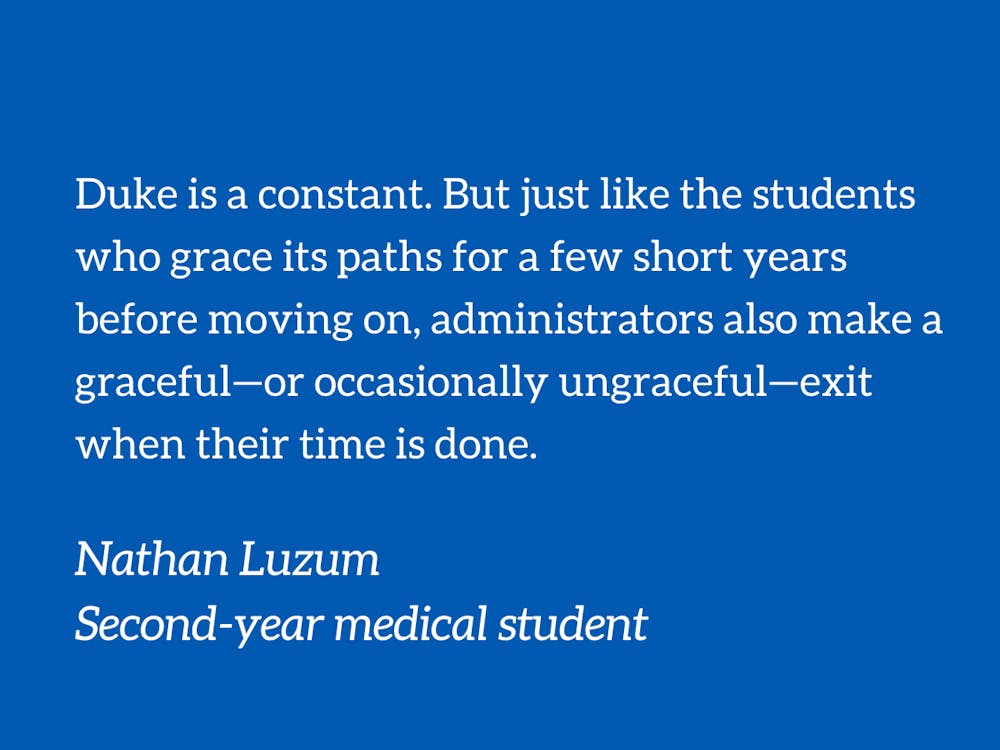In the period of a week, two of Duke’s most influential administrators announced their departures. Provost Sally Kornbluth will leave her role to take the reins as president of the Massachusetts Institute of Technology in January, and A. Eugene Washington, president and chief executive officer of Duke Health, is stepping down at the end of June.
These two departures are just the latest in a wave that has brought in a flurry of fresh faces to occupy the University’s top echelon of administrators.
When a new university president takes over, as Vincent Price did in 2017, it’s generally accepted they get to reform their cabinet in a way that aligns with their vision. Whether due to personality clashes, philosophical differences or just retirement for retirement’s sake, a presidential takeover typically precedes administrative turnover. Price’s first term was no exception, with considerable change in the academic, administrative and student life realms.
On the academic side, of Duke’s 10 schools, only the Fuqua School of Business has a dean whose tenure precedes Price’s, with Bill Boulding serving in that role since 2011. From Nancy Andrews leaving the School of Medicine in 2017 to Valerie Ashby’s departure from Trinity College for UMBC’s presidency this summer, the faces leading Duke’s academic programs have undergone a massive overhaul.
The University’s administrative side has also evolved over the past few years. Tallman Trask and Richard Riddell, both major power players with a combined four decades in their positions, retired in 2020. Many of the vice presidential roles have new occupants, perhaps the most prominent being the successor of Michael Schoenfeld, who was Duke’s chief spokesperson and charged with maintaining the University’s image.
Finally, the student life side hasn’t been spared from these changes. Along with the introduction of QuadEx have come Mary Pat McMahon and Gary Bennett to smooth over the controversy that marked the end of Larry Moneta’s tenure as vice president for student affairs. Dean Sue and her 50 years of service to Duke were a casualty of what appeared to be friction within the Student Affairs department.
Taken as a whole, these past five years have seen the departure of considerable institutional knowledge. There will always be administrators coming and going at large research universities like Duke, but the recent past has exemplified that to an exceptional degree. (As someone who matriculated as a first-year here in 2016, I feel particularly old when I realize that I’ll have been at Duke longer than pretty much every high-level administrator. Maybe my dark-horse campaign for provost begins now.)
With this new cadre of administrators, Price will have the remainder of his second term to cement his legacy at Duke—and possibly a third, if he is reappointed in 2027.
Duke’s last two presidents, Nannerl Keohane and Richard Brodhead, and their inner circles both left strong legacies in their wake. The extensive construction under Keohane’s presidency from 1993 to 2004 physically changed the face of Duke, and her commitment to Duke’s academics and international ties intellectually transformed the University. With this reputational elevation came a social crackdown on nightly keg parties that had carried campus social life and a housing shakeup in which East Campus became an exclusively first-year campus.
Brodhead inherited a changed Duke in 2004 and was quickly met with tests amid the Duke lacrosse case and Great Recession. Nonetheless, he continued the international expansion with the beginning stages of Duke Kunshan University and oversaw the creation of DukeEngage. Capping off his terms was the renovation of West Union, completed in 2016, now bearing his name as the Brodhead Center.
What will Price’s legacy be? Marshaling Duke through COVID-19 academically and financially will certainly be a significant part of it, as will creating a more inclusive housing environment through QuadEx and the phasing out of Central Campus. Moving all non-first-years to West Campus, which seemed like a feasible goal to complete by the mid-2020s before the pandemic threw a wrench in new dorm construction, is likely more of a long-term plan now. Determining the future of Central Campus—now existing as an adrift liminal space—is perhaps the most salient mark that Price could leave in the years to come. And, of course, by having a strong voice in reforming virtually every top administrative position, Price will set in place administrators whose tenures will outlast his own.
Regardless, these recent presidential promotions—Kornbluth to MIT and Ashby to UMBC—are a testament to how the University’s name has grown on the national stage. For the first time in recent memory, Duke administrators are catching other institutions’ eyes to earn their highest position. Their replacements, alongside Washington’s successor, will be essential to guiding Duke into its next chapter. As search firms specializing in headhunting the best in the higher education landscape compile names, the search process will begin (a process that I find fascinating and detailed here in a story from several years ago). Historically, the provost has been an internal hire whereas the Trinity College dean and health system chancellor have leaned more externally.
Duke is a constant. But just like the students who grace its paths for a few short years before moving on, administrators also make a graceful—or occasionally ungraceful—exit when their time is done. It’s this dyadic relationship between students and administrators, ever-changing over the years, that forms the zeitgeist. As far as what the next phase holds, only time will tell.
Nathan Luzum is a second-year medical student and a member of the DSPC Board of Directors. His column runs on alternate Wednesdays.
Get The Chronicle straight to your inbox
Signup for our weekly newsletter. Cancel at any time.

